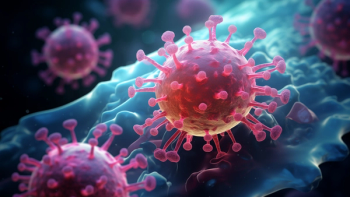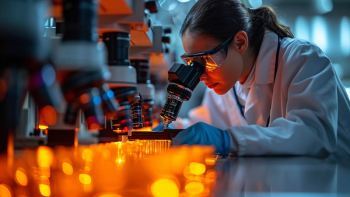
- Pharmaceutical Executive-10-01-2007
- Volume 0
- Issue 0
R&D Innovation: An Answer to Cancer
Cancer R&D IS booming right now. At a time of poor ratings on both Wall Street and Main Street, pharma can at least point proudly to its oncology pipeline as proof that it still takes big risks to make big advances against big killers-and win. According to a recent IMS report, the cancer pipeline contains 380 compounds, with nearly 100 in Phase III. The long-established standard of care-surgery, radiotherapy, and chemo-is fast giving way to a high-tech array of targeted therapies. These molecules and antibodies are designed to block specific disease pathways, and they are proving both far more effective and far more tolerable than the sledgehammer status quo. Since 1996, the overall survival rate for patients has jumped by 30 percent, from one-half to two-thirds.
CANCER R&D IS BOOMING RIGHT NOW. At a time of poor ratings on both Wall Street and Main Street, pharma can at least point proudly to its oncology pipeline as proof that it still takes big risks to make big advances against big killers—and win. According to a recent IMS report, the cancer pipeline contains 380 compounds, with nearly 100 in Phase III. The long-established standard of care—surgery, radiotherapy, and chemo—is fast giving way to a high-tech array of targeted therapies. These molecules and antibodies are designed to block specific disease pathways, and they are proving both far more effective and far more tolerable than the sledgehammer status quo. Since 1996, the overall survival rate for patients has jumped by 30 percent, from one-half to two-thirds.
Given this gold rush, it's a bit of a shock to hear distinguished cancer researcher Joseph Bolen bemoan the current state of his art. The chief scientific officer of Millennium—the Cambridge, MA–based biotech that shot out Velcade, for multiple myeloma, in a mere four and a half years—points out that oncology R&D has the lowest success rate of any therapeutic area. But Bolen is not one to sit back and complain. As chairman of last August's 12th Annual World Congress on Drug Discovery and Development of Innovative Therapeutics, in Boston, Bolen held a panel called "Why Is Cancer Drug Discovery So Difficult?" We caught up with him afterward to get the answer—and what to do about it.
So tell us—why is cancer drug discovery so difficult?
Even when we enter clinical trials with a molecule that has passed all of the discovery and safety hurdles, there's only a 5 percent chance that it will go through clinical trials and come out a commercially viable product. That is the lowest success rate of any therapeutic area in the industry.
So that's quite a challenge from a number of points. Once you've made the substantial investment to do all the early work that goes into filing the IND [Investigational New Drug application], the compound doesn't change. Either you've gotten it right or it's going to fail—there's nothing different about oncology there. What is unique about oncology is that Phase I clinical trials, for the most part, are in patient populations rather than in healthy volunteers. And, of course, the patients that you're seeing in Phase I, which is supposed to be just a safety study, are basically patients who have failed virtually every other therapy. So there is a real hurdle in order to get any glimpse of efficacy at all. That has put a tremendous burden on trying to sort out relevant biomarkers.
What we're faced with in Phase I is the accumulated evolution of tumors that have survived previous therapies and metastasized. Trying to assay what's going on inside the tumor is also quite difficult because, again, these patients are usually not feeling well. The idea of a biopsy to see if your drug is doing something is quite a hurdle to get over.
Generally, the majority of our current animal models are poorly predictive of what we are looking at in the clinic. You have a great variety of tumor phenotypes in the same patient—rarely are they clonal [genetically identical]. And unlike many diseases, cancer is a collection of proliferative diseases that represent hundreds, if not thousands, of different specific diseases. There are also enormous differences among patients.
So it's almost miraculous that you see anything in Phase I to figure out early on what your compound is actually doing. What you're really trying to do is move to a Phase II trial where you are picking specific cancer types, and you're also trying to determine a dose and a schedule for patients.
And if you manage to get to Phase III, you're rarely using a single agent, because cancer patients are normally treated with multiple drugs at the same time. You take the standard of care and add your drug on top of it. So it's little wonder that, with the complexity here so much greater than for many other indications, cancer drugs generally fail in Phase III—the most expensive part of drug development.
And yet, at the same time, an enormous amount of the clinical pipeline is cancer drugs these days.
There are almost 400 different compounds being tested in the clinic right now, just in the United States alone. That's a dazzling array of trials to keep track of. It's very competitive these days.
One thing that's always puzzled me about cancer R&D is that, theoretically, one of the big victories would be drugs given in early stages of disease. Yet the research is done in the most extreme cases, presumably because you can have much faster clinical trials, and efficacy—measured by saving a couple of weeks of life—is often enough to get the compound past the first hurdle. Is anybody working on drugs for early-stage cancer?
We do it this way basically because of an ethical concern. It would be a different story if we had good disease biomarkers—like, say, increasing cholesterol levels for atherosclerosis in heart disease—but we don't.
And until those become available, if you're a cancer patient and your disease is detected early enough, surgery is the most effective means of dealing with it. Unfortunately, that doesn't work for everybody. So then you're going to need chemotherapy. And there is usually a set algorithm of choices of chemotherapeutics or radiation that have been shown to be effective in one way or another. The treatment might be a little tough, but this is the standard of care. For a doctor to say to a patient, "Let's not treat you with the standard of care, we want to use an experimental drug that may not even work"—well, that's a pretty impossible argument. At most, they'll say to us, "Well, prove to me that it works in at least some setting and then we'll think about it." That's why we start with the relapsed-refractory patients—first showing that the molecule is safe, and then what it can do as a single agent against a specific cancer, and then in combinations with other therapies that look like the standard of care.
Once you get approval, you're going to spend the next five to seven years doing additional clinical trials trying to move your compound up toward first line. And if you're lucky enough and the compound is good enough, you'll finally reach standard of care. That's one of the fundamental differences between an oncology drug and one for rheumatoid arthritis or asthma or some other disease. This lack of biomarkers, coupled with the ethical considerations, is a very significant problem.
Let's get specific: Are there no biomarkers at all?
There are a very limited number. The classics are PSA for prostate cancer, CA-125 for ovarian cancer, and M protein for multiple myeloma. There's really not a lot in breast cancer or colorectal cancer, for example, in terms of circulating markers, but that's why mammograms and colonoscopies are useful.
In addition to finding biomarkers, what else can be done to improve the discovery and development of cancer drugs?
I'm more optimistic now than I ever have been, because we're starting to see this significant shift from old-fashioned cytotoxic drugs. The vast majority of cancer treatments approved these days are targeted therapies generated over the past 10-plus years with the input of molecular oncology, genomics, and all the other technologies that have been developed.
And we're going to figure out how to blend these targeted therapeutics in combinations so that we're treating the underlying cause of the disease rather than its manifestations. Most traditional chemotherapeutics block proliferation, but targeted therapies are aiming at the molecular elements of cancer. There are eight biological characteristics of cancer cells that need to be addressed in order to attack these underlying disease mechanisms: self-sufficiency in growth signals, insensitivity to antigrowth signals, evasion of apoptosis, limitless replicative potential, sustained angiogenesis, tissue invasion, metastasis, and therapeutic resistance.
These characteristics and their associated pathways are all being defined. And we are on the cusp of being able to use our therapies more strategically because we can now profile a cancer at the molecular, rather than just the anatomical, level—and that's where all the action is. The better we get at understanding the early aspects of disease, the earlier we'll be able to target those pathways.
Of the drugs in development, or even on the market, which best represent the direction you think that discovery in oncology is moving?
The poster child, of course, is Gleevec [approved for chronic myeloid leukemia, or CML]. There, you can make a diagnosis and if the patient has the Philadelphia chromosome, then you know exactly what subtype of disease you're looking at. You have a specific drug that targets the specific molecular alteration, and that means its side effects are few and its efficacy is extraordinarily high. So we're trying to turn more common cancers into the situation that you see with CML.
Some other new targeted therapies include Tarceva [approved for non-small cell lung cancer and pancreatic cancer] and the anti-VEGFs [vascular endothelial growth factors], like Avastin. There are additional interesting compounds hitting other pathways, such as the IGF [insulin-like growth factor] pathway, the PI-3 kinase pathway, the WNT pathway, the ubiquitin and ubiquitin-like pathways, to name just a few.
In fact, there are hundreds of targeted therapies in clinical trials worldwide, each with its own idea about what pathway is important. And clinicians will start working together to figure out what combinations are used in what order to drive the metastatic malignant process to a chronic therapy.
We'll wrestle this to the ground. We'll have an up-front therapy and a whole range of strategies: If the cancer comes back, we're going to use this combination of drugs, and when it comes back after that, we're going to use that combination. The idea is to turn what could be acutely life-threatening into, basically, a chronic disease that we manage.
What do companies need to be doing now to make that happen? Or is it more than companies? Is it academic researchers? Is it FDA?
With respect to the application of biomarkers and patent stratification to early clinical trials, it absolutely must be done at the company level—but in close partnership with the clinical centers where the trials are being conducted. Over the three days that we talked about projects at this drug discovery and development meeting, I can't remember a single company that does not have a clear biomarker strategy to figure out whether their drug hits the target intended. So it is now embedded in every project that I'm aware of. The old standard of imaging analysis to see if the tumor shrinks does not work anymore, because a lot of these new compounds are not cytotoxic but cytostatic—they're intended to stop the tumor from growing but do not necessarily result in single-agent tumor shrinkage.
All across the board, biomarker strategies and new ways to design clinical trials are ongoing. And, again, at the heart of targeted therapy is the idea of understanding the biology of cancer and then translating that into clinical medicine.
When biomarkers are available, does that offer a way out of the trap of having to start every drug with the sickest patients?
No, it doesn't. You still have to deal with the same patient populations, but it allows you to ask specific questions about your compound to make sure you've gotten enough compound into the patient at a safe enough level to see biological implications. And then—whether by taking blood, skin, or tumor samples—you can ask, "Has the compound actually hit the target, and if so, has it shut off the pathway that leads to either the growth or the survival of those specific types of cancers?"
And that's one way to think about setting the doses of these therapeutics as opposed to just giving increasing doses over the course of time until something toxic happens and you have to stop. It's a more informed way of doing clinical research, but you're still starting with the same patient population.
Do you also work with them in Phase III?
In principal, once you define your dose and schedule and can relate the plasma levels of a drug to an efficacious exposure, then perhaps the Phase III design might be less dependent upon biomarkers. However, this assumes that the drug combination chosen for the Phase III trial will not somehow modify the behavior of the experimental compound. This is one of the reasons that companies are conducting larger, randomized Phase II trials with designs similar to the potential Phase III design but on a smaller scale.
I once heard Judah Folkman talk about the discovery of Avastin and how, in some early trials, it wasn't showing any effects. It turned out that by the time they tested the drug in patients, there were four or five pathways working at the same time to grow blood vessels for the tumor—so if you looked at tumor growth, the drug failed; if you looked at the growth of the blood vessels, it failed; but it was, in fact, working on the pathway it was supposed to be working on.
Avastin is an interesting example, because it was indeed unlikely to have significant single-agent activity in the first set of patients treated. That would have been fantastic, but not expected. Most everyone assumed that the antiangiogenic therapies would be more useful in a combination setting. And, happily, that turned out to be true.
As we make progress in our understanding of angiogenesis, it is clear that the VEGF axis is going to continue to be really important. But there are other pathways that have been defined, so we'll see combinations of antiangiogenic compounds being used to treat patients. And if they're safe enough and effective, we'll see those marching up to approval of front line over a more accelerated time than more potentially toxic compounds.
So what's next?
This is an area of research that changes rapidly. For example, of the emerging themes now in oncology, number one on the list is cancer stem-cell population as a driver of long-term disease. The idea is that by treating the bulk tumor, you're not getting at the heart of the disease—the stem cells or progenitor cells or initiating cells driving the disease. And we're just starting to learn more about their biology. Another emerging theme is the idea of the normal tissue surrounding cancer cells—the so-called cancer stroma—playing important roles in the biology of different cancers. In so many ways, this is a fascinating field and progress truly is being made every day.
Articles in this issue
about 18 years ago
Some Alzheimer's Patients Left Behindabout 18 years ago
Hits Like a BRICabout 18 years ago
What's Worrying Sales?about 18 years ago
Medicare Part D Puts the Focus on Pricesabout 18 years ago
Radio Activeabout 18 years ago
Shade-Tree Syndromeabout 18 years ago
It's Standards Timeabout 18 years ago
Lifecycle: End Gameabout 18 years ago
Waiting for Reform. Major Reformabout 18 years ago
The Wiki IncidentNewsletter
Lead with insight with the Pharmaceutical Executive newsletter, featuring strategic analysis, leadership trends, and market intelligence for biopharma decision-makers.





